

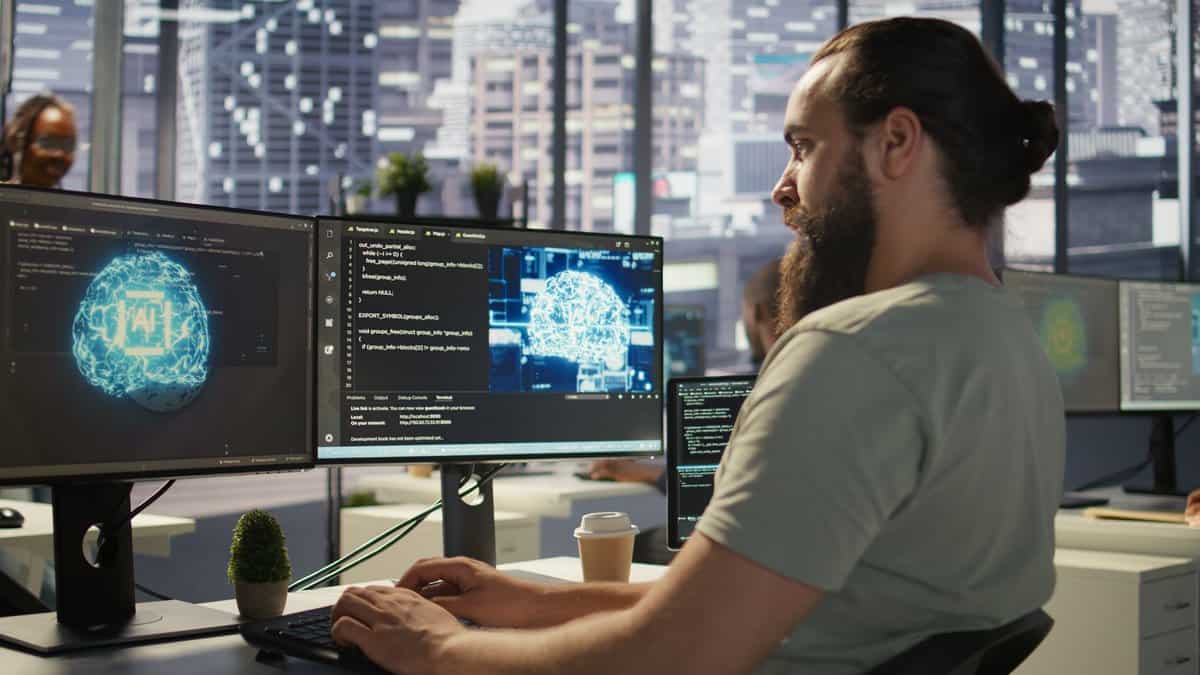
Artificial intelligence has rapidly transformed from experimental technology to essential business infrastructure, with computer vision emerging as one of its most impactful applications. This visual perception capability now powers critical operations across industries, from manufacturing quality control to healthcare diagnostics. The healthcare sector demonstrates how AI-powered visual analysis transforms clinical diagnostics. Research published in the renowned science journal, Nature, indicates that machine learning trained computer vision systems already surpass human radiologists in accuracy, especially in detecting breast cancer.
“An artificial intelligence model has been developed that is better at spotting breast cancer in mammograms than expert radiologists.”
This superior detection capability illustrates how visual AI technologies deliver measurable improvements in fields where precision directly impacts patient outcomes.
Companies that implement visual analysis tools gain measurable improvements in quality control, security monitoring, and customer behavior tracking—far beyond what manual observation can deliver.
The global computer vision market, valued at USD 25.41 billion in 2024, is projected to reach USD 175.72 billion by 2032, exhibiting a CAGR of 27.6% during the forecast period, driven by computational advancements.
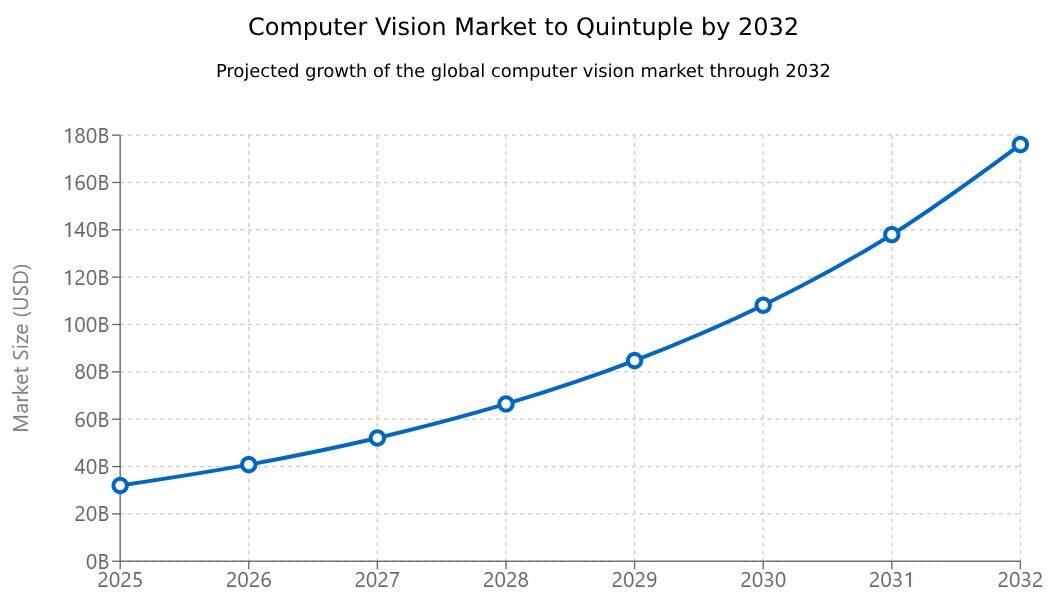
Source: Fortune Business Insights
Advanced hardware like Nvidia’s GB200 GPUs now processes complex models in seconds, enabling real-time applications in autonomous driving, augmented reality, and robotics. Organizations implementing these technologies gain competitive advantages through automated visual inspection, enhanced security systems, and improved customer experiences. This article examines fundamental computer vision concepts, implementation approaches, and how DevsData LLC’s expertise delivers transformative solutions across diverse business scenarios.
Computer vision represents a specialized branch of artificial intelligence that employs machine learning algorithms and neural networks to extract valuable insights from visual data sources, including digital photographs, video feeds, and other optical inputs. This technology enables systems to process visual information, recommend solutions, or initiate appropriate responses when detecting irregularities or problems. While AI provides computers with reasoning capabilities, computer vision supplies them with visual perception, observation, and recognition abilities. Computer vision functions similarly to human sight, though people benefit from a significant advantage. Human vision builds upon lifetimes of contextual experience that teach us to differentiate objects, gauge distances, detect movement, and identify visual anomalies.
For example, a computer vision system in manufacturing can scan thousands of items on a production line and automatically flag even slight scratches or color variations in real time.
Instead of relying on human inspectors who might miss defects due to fatigue or inconsistency, the system applies the same detection criteria every time, improving accuracy and speed.
This reduces product recalls and ensures consistent quality without slowing down production.
Machines require training to replicate these visual capabilities, but must acquire these skills much more rapidly using cameras, data processing, and specialized algorithms rather than biological components like retinas, optic nerves, and visual cortices. A properly configured computer vision system can examine thousands of products or monitor numerous processes every minute, identifying subtle defects or issues that might escape human detection, ultimately surpassing conventional visual inspection capabilities.
Computer vision systems require extensive data inputs. These systems repeatedly analyze information until they can identify distinctive features and eventually recognize complete images. For instance, when teaching a computer to identify car tires, developers must supply numerous tire images alongside pictures of related objects to help the system learn distinguishing characteristics and accurately recognize tires, particularly those without defects.
This process relies on two fundamental technologies: Deep Learning (a specialized machine learning) and Convolutional Neural Networks (CNNs).
Machine learning employs algorithmic models enabling computers to understand visual data context. When sufficient information passes through these models, the computer examines the data and teaches itself to differentiate between images. These algorithms allow autonomous learning rather than requiring explicit programming for image recognition.
CNNs assist machine learning or deep learning models with visual processing by decomposing images into pixel-level components with assigned tags or labels. The network uses these labels to execute convolutions (mathematical operations combining two functions to produce a third) and generates predictions about the visual content. Through multiple iterations of convolutions and prediction accuracy checks, the neural network gradually improves until its predictions become reliable. At this point, the system recognizes images in a manner comparable to human visual processing.
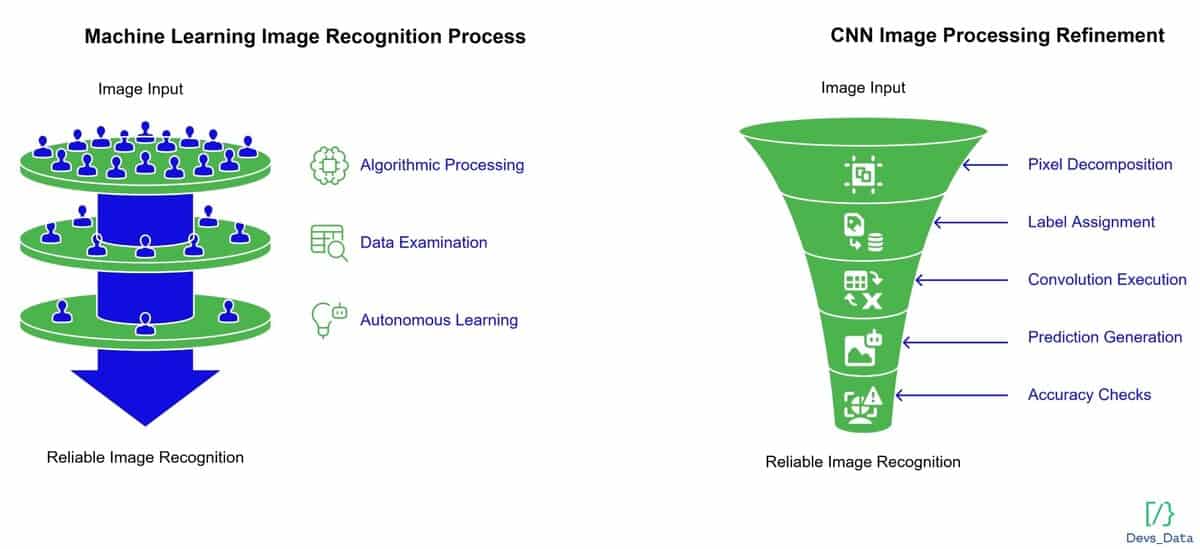
Similar to how humans discern distant objects, CNNs initially identify defined edges and basic shapes before gradually filling in details through iterative prediction refinement. While CNNs process individual images, Recurrent Neural Networks (RNNs) serve a comparable purpose for video analysis, helping computers understand relationships between sequential frames in video content.
Developing a computer vision system involves several interconnected stages that transform raw visual data into high-performing AI solutions. Today’s workflows emphasize automation, reusability, and adaptability over rigid step-by-step development.
Do you have IT outsourcing needs?
Each development stage requires specialized expertise beyond general programming knowledge, explaining why organizations typically engage professional computer vision development services rather than attempting internal implementations with general-purpose tools.
Computer vision development services help businesses turn visual data, like photos, surveillance feeds, or product images, into actionable insights that improve operations, reduce errors, and support decision-making. These services automate tasks traditionally reliant on human observation, such as monitoring production quality, identifying safety risks, verifying customer identities, or managing inventory in retail environments.
Rather than relying on generic tools, companies work with specialized providers to develop systems tailored to their specific industry needs. For example, a manufacturer might implement a vision solution that flags defects on an assembly line in real time, helping reduce waste and minimize recalls. A retailer could track product stock automatically using intelligent shelf monitoring, while a logistics firm might monitor package conditions through visual checks during transit.
These development services cover the entire process, from identifying the business problem to building a customized solution that integrates smoothly with existing workflows. A key benefit is the ability to align the technology with measurable outcomes, such as faster processing times, fewer manual errors, better compliance reporting, or improved safety response.
Off-the-shelf software may offer basic features, but professional services ensure the system reflects the company’s operations, environment, and data. The result isn’t just automation—it’s a smarter, more responsive business process that scales with organizational needs.
Most businesses lack sufficient internal resources to establish dedicated computer vision labs or develop sophisticated deep learning models and neural networks. Additionally, they often struggle with the limited computational capacity for processing extensive visual datasets.
Various technology providers now offer specialized computer vision development solutions to address these challenges. These services provide access to pre-trained learning models through cloud platforms and reduce computational resource demands. Clients connect to these services via Application Programming Interfaces (APIs) and leverage them to build custom computer vision applications.

Although accessing computer vision development resources has become more straightforward, a critical early step remains: defining exactly what the application should do. Clear objectives focus development, support validation, and help ensure successful deployment.
Several practical computer vision applications are already in use across industries:
By focusing on well-defined, high-impact tasks, organizations can move beyond experimentation and deploy computer vision systems that deliver real operational value—faster service, higher accuracy, or cost savings.
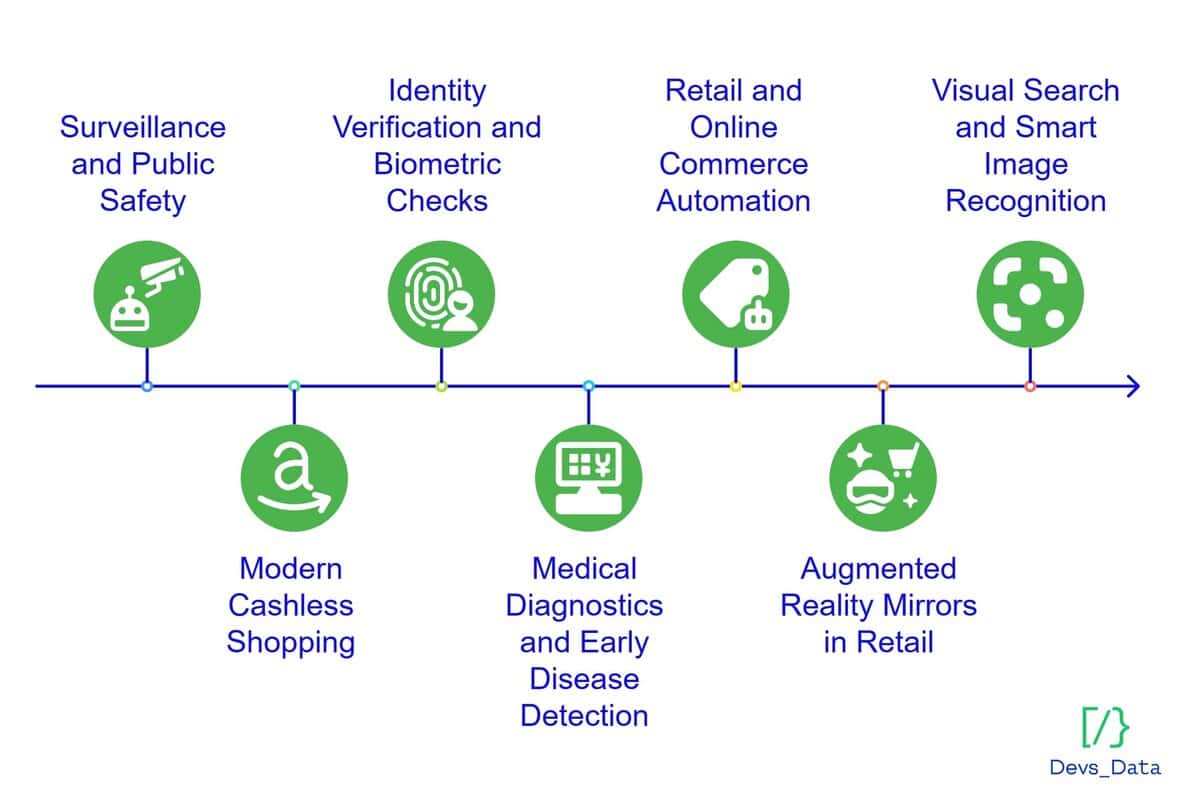
In large cities such as Dubai and London, advanced computer vision technology is now embedded in surveillance systems. CCTV and security cameras are connected to AI models that continuously monitor public spaces. When the system detects unusual activity or potentially dangerous items, it immediately alerts human officers to investigate. This real-time automation helps prevent incidents and supports faster responses to safety concerns.
“London’s Metropolitan Police scanned over 4.7 million faces using live facial recognition in 2024, more than double the previous year’s figure, as the technology becomes more widely deployed in city surveillance.”
Retailers are redefining the in-store experience with computer vision at the core. Shops like Amazon Go in the US and Zabka Nano in Europe allow customers to walk in, pick up items, and leave without visiting a cashier. The system automatically tracks what is taken and deducts payment from the customer’s account. This approach removes friction from shopping and demonstrates how vision AI can streamline everyday transactions.
Secure identification now relies on computer vision for everything from banking to online account creation. Vision systems analyze live video to confirm the user’s presence, compare facial features, check biometric factors such as eye color or skin tone, and verify authenticity against provided ID documents. These processes support fraud prevention and reliable authentication across a range of industries.
Healthcare professionals are increasingly supported by computer vision tools that review radiological images. AI models highlight subtle patterns that might go unnoticed, such as early signs of disease in mammograms. By flagging these indicators, vision systems help doctors provide more accurate diagnoses and give patients the benefit of earlier intervention.
eCommerce platforms are speeding up the listing and management of products using vision algorithms. These systems can identify popular retail items in photos or videos, automatically tag them, and streamline publication for sellers on sites like TikTok Store, Shopify, and Pinterest. Automated tagging helps sellers reach customers more efficiently and supports affiliate marketing for online stores.
Augmented reality mirrors are changing how people shop for fashion, beauty, and home decor. Brands like Zara, H&M, Sephora, and Ikea use AR mirrors to offer virtual try-ons, letting shoppers see how clothing, accessories, makeup, or furniture might look before deciding. These tools enhance personalization, reduce returns, and increase engagement both in physical stores and online.
Computer vision powers tools like Google Lens, making it possible to identify objects in images, extract and translate text, or even match photographed locations to places on a map. These features bring immediate value to users, allowing them to learn more about their surroundings or find products and information with just a photo.
Computer vision is becoming a practical part of daily life, powering the tools and services people depend on—from city safety to how they shop and connect with information.
Modern computer vision applications demand specialized expertise and custom solutions that many organizations lack internally. DevsData LLC provides tailored vision systems that transform visual data into actionable business intelligence, focusing on processing optimization and accuracy refinement across industries.
A defense sector client required a specialized solution for precise human detection and posture analysis in real-time video footage while operating under strict hardware constraints for field deployment. Their operational requirements demanded reliable performance in variable lighting conditions without the computing resources typically needed for deep learning implementations.
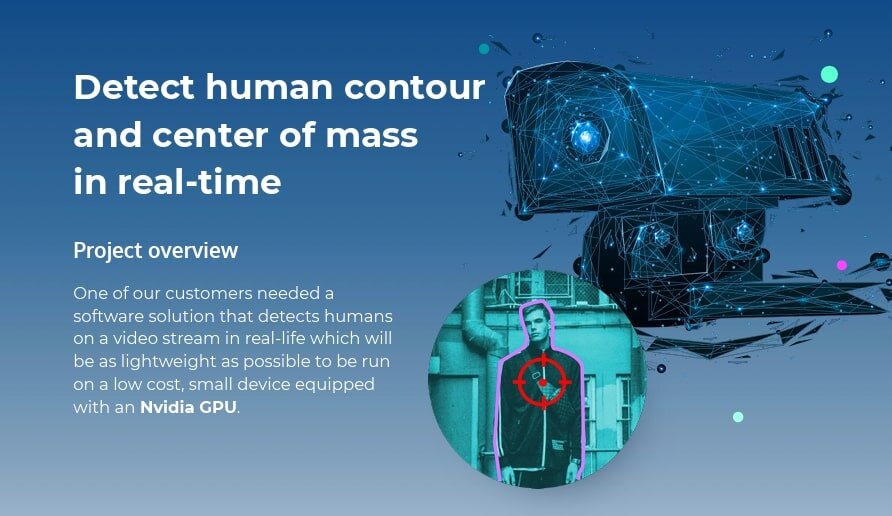
DevsData LLC developed a lightweight, efficient computer vision system explicitly tailored for deployment on edge devices with limited computing power. The solution enabled real-time human detection and movement analysis without relying on large-scale processing infrastructure. This allowed the client’s field teams to conduct surveillance and threat monitoring in remote areas while maintaining full situational awareness.
DevsData LLC delivered a solution that functioned consistently even under unstable lighting conditions by optimizing the system for performance on Nvidia Jetson hardware. The system supported advanced posture recognition, helping the client distinguish between neutral behavior and potential threats, critical in high-risk environments. Additionally, the deployment minimized reliance on manual monitoring, reducing operator fatigue and improving decision-making speed in the field.
This project demonstrated how customized, resource-efficient vision systems can offer military and defense clients a tactical edge, combining operational reliability with timely, actionable intelligence under real-world constraints.
A leading American drone technology company, SkyCatch, Inc., partnered with DevsData LLC to develop a real-time video analytics system designed for the construction industry. The client needed a robust, deployable solution to detect, count, and analyze equipment and activity directly from drone video feeds, delivering actionable insights for smart construction sites.
DevsData LLC engineered a deep learning-based system capable of processing live video on Nvidia Jetson devices, meeting stringent speed, accuracy, and edge deployment requirements. The development team evaluated multiple model architectures, including RCNN and Faster RCNN, and ultimately adopted the YOLO (You Only Look Once) network for real-time object detection. The solution combined YOLO with an LSTM layer to enhance detection accuracy and temporal understanding, allowing for both object tracking and activity recognition across video frames.
The data pipeline leveraged both client-provided footage and publicly sourced construction videos, enabling comprehensive training and validation. Models were trained using the Keras framework with a TensorFlow backend, with deployment packaged in Docker containers to ensure reliable, scalable operation in diverse environments.
This advanced analytics solution enabled SkyCatch, Inc. to deliver detailed site activity reports and equipment utilization metrics, providing immediate value to construction stakeholders. The project was a significant commercial success, helping SkyCatch, Inc. secure continued business from large enterprise clients and attract new investment, including a major round led by a prominent Japanese construction group.
The project’s rapid development, clear communication, and business results received strong recognition from the SkyCatch leadership team:
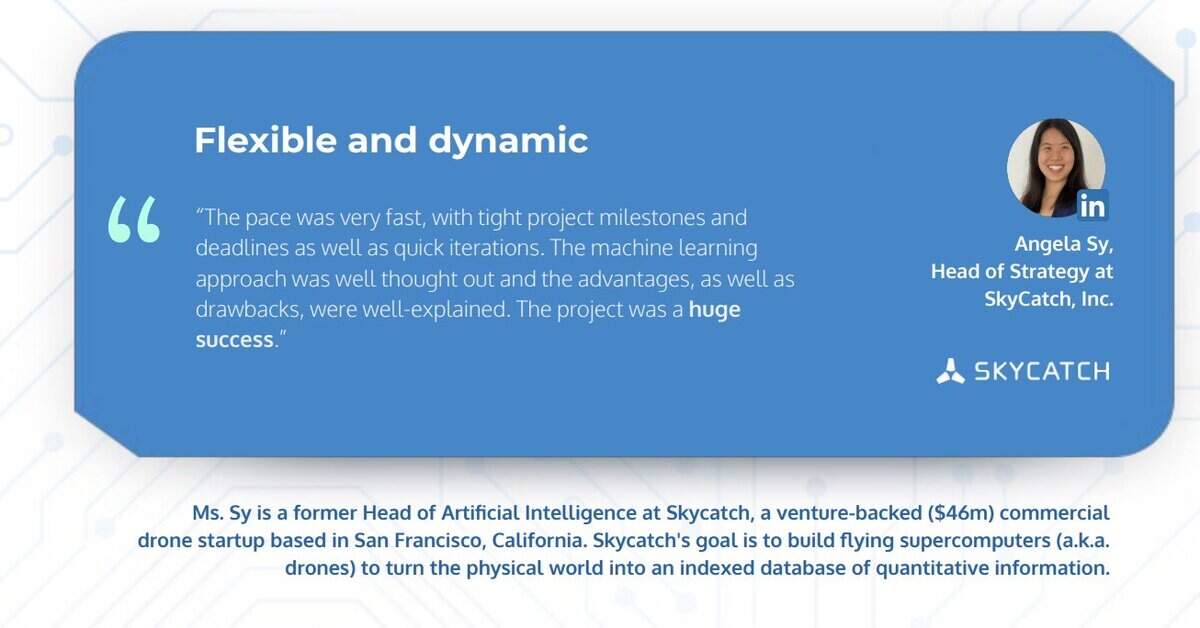
A pharmaceutical company needed a way to detect Adverse Drug Reaction (ADR) more efficiently and in near real-time. Manual monitoring processes were slow and often failed to capture early warning signs from non-traditional sources. DevsData LLC delivered a solution that improved pharmacovigilance by expanding data coverage and automating key monitoring activities. The system’s impact came from three core components:
Do you have IT outsourcing needs?
For the financial sector clients, DevsData LLC created an advanced market intelligence system combining computer vision with Natural Language Processing (NLP) to identify investment signals before they became widely recognized. This solution addressed the challenge of extracting actionable intelligence from overwhelming volumes of unstructured financial information. Three key capabilities drove the results:
The success of a computer vision project often depends less on generic vendor traits and more on how well the provider understands real-world business problems, builds reliable systems, and supports outcomes that extend beyond deployment. When evaluating potential partners, organizations should prioritize the following:
Proven track record in applied projects: Look for providers with case studies that show how their solutions perform in operational settings, not just technical demos. Results tied to measurable improvements (e.g., fewer defects, faster detection, reduced costs) are especially valuable.
Domain-specific experience: Computer vision requirements vary widely across sectors. A provider that has delivered solutions in manufacturing, defense, retail, or healthcare is better equipped to anticipate context-specific challenges, such as variable lighting, hardware limitations, or compliance restrictions.
Strong technical foundation: Beyond general AI capabilities, vendors should demonstrate expertise in vision-specific model architecture, deployment optimization, and data preparation techniques. This ensures systems work in theory and hold up under production constraints.
Integration and scalability planning: Effective vendors deliver solutions that seamlessly integrate with existing business systems and adapt over time. This includes cloud/on-premise flexibility, edge deployment readiness, and API-based integration with internal tools or dashboards.
Post-launch support and performance monitoring: Vision systems evolve. Providers should offer structured support for retraining models, updating them based on user feedback, and tracking long-term performance to ensure sustained business value, rather than one-off delivery.
Selecting a vendor with deep technical expertise, operational awareness, and a proven track record of delivering results in similar environments significantly increases the chances of project success.
Computer vision implementations differ substantially across business sectors. Exceptional development firms concentrate on specific industries rather than pursuing universal capabilities.
Medical applications require uncompromising precision while adhering to compliance standards. Store environments demand systems functioning reliably despite inconsistent lighting conditions. Factory implementations necessitate extraordinary accuracy when identifying minuscule imperfections.
“Premier companies comprehend these sector-specific demands and develop appropriate solutions. This specialized understanding influences everything from initial data acquisition to final system deployment.”
In computer vision projects, the quality and accuracy of visual data often determine whether a system delivers reliable results or produces costly errors. The effectiveness of even the most advanced models depends on how well the underlying data reflects real operating conditions.
Top-performing providers focus on data not as a technical step, but as a core business enabler:
Additionally, companies that handle sensitive visual data, such as medical imaging or surveillance footage, must have security protocols in place to prevent leaks, ensure privacy, and comply with regulatory requirements. Business stakeholders should expect clear controls over access, retention, and data use.
For organizations investing in vision systems, strong data practices aren’t just technical hygiene—they directly support business continuity, regulatory compliance, and overall system trustworthiness.
The gap between standardized vision products and fully customized implementations becomes increasingly significant as applications grow more complex. Leading development partners deliver personalized solutions addressing specific business problems while supporting future expansion needs.
This customization approach begins with solution architecture fundamentals. Instead of adapting business requirements to existing frameworks, premier providers thoroughly analyze specific challenges before designing appropriate solutions. They understand that while established models offer valuable foundations, tangible business value emerges from adapting these elements to particular usage contexts.
Many organizations showcase impressive demonstrations, but superior providers implement systems that perform consistently in practical applications. These providers consistently:
Website: www.devsdata.com
Company size: ~60 employees
Founding year: 2016
Headquarters: Brooklyn, NY, and Warsaw, Poland
Successful computer vision implementation requires both theoretical knowledge and practical application skills. Companies looking for sophisticated image analysis systems gain considerable advantages by collaborating with teams that thoroughly understand this specialized technology area. DevsData LLC employs a holistic method for computer vision projects that connects precise algorithm development with real-world functional needs. Their systematic process combines advanced visual analysis techniques with specific business goals, allowing organizations to convert image data into valuable business intelligence. This integrated strategy helps clients utilize powerful computer vision capabilities while ensuring systems perform effectively in operational settings.
Throughout more than 8 years of operating in the technology industry, DevsData LLC has built an established reputation across multiple business sectors. Their senior engineers each bring over 10 years of experience and have led complex vision system deployments in high-stakes environments, ranging from defense to healthcare. This is supported by a broader team with deep expertise in machine learning and Big Data and Machine Learning integration, ensuring dependable performance in real-world conditions. This specialized knowledge allows their google-level in-house engineers to develop image processing systems that go beyond basic recognition to include sophisticated functions such as contextual understanding, pattern detection, and predictive analytics. Their extensive project history encompasses over 100 completed software initiatives for more than 80 global clients, consistently achieving perfect 5/5 customer satisfaction scores on independent review platforms, Clutch and GoodFirms.
With clients across multiple industries, DevsData LLC maintains US-based technical experts who work in coordination with their worldwide team through methodical development frameworks, ensuring consistent quality delivery regardless of project complexity or location. Their client portfolio includes international corporations and emerging growth companies from numerous countries globally, with notable projects in the US and Israel. This broad geographic experience enhances their capacity to handle varied requirements for computer vision systems across different markets and operational environments.
Implementing effective computer vision technology requires expert understanding of neural networks, data preparation, and deployment approaches. DevsData LLC’s specialists excel in creating tailored vision models with high recognition accuracy while maintaining efficient processing requirements, prioritizing operational effectiveness over theoretical perfection.
Their distinctive approach combines machine learning technologies with established computer vision principles, producing hybrid solutions that leverage multiple technical approaches. This methodology addresses complex visual data processing requirements while maintaining the dependable performance essential for business-critical applications.
In addition to projects in manufacturing, healthcare, and finance, DevsData LLC has also delivered innovative solutions in the sports and entertainment industry. One notable engagement involved collaborating with ReSpo.Vision, a leading technology company focused on modernizing football analytics.
For this project, DevsData LLC developed advanced computer vision and deep learning models capable of detecting football players automatically from match footage. These algorithms analyze video streams to identify players, track their movements, and generate actionable statistics throughout the game. The resulting insights help football clubs, coaches, and analysts better understand team dynamics, player performance, and tactical trends, without relying on manual data entry.
This experience highlights DevsData LLC’s versatility and ability to adapt computer vision technology to various industry challenges, including complex, fast-paced environments like professional sports. DevsData LLC continues to help clients unlock new value through intelligent visual data analysis by bringing together deep technical expertise and a strong focus on practical outcomes.
Do you have IT outsourcing needs?
For additional information about their computer vision development capabilities, interested companies can reach DevsData LLC at general@devsdata.com or find more details on their website at www.devsdata.com.
These technologies improve how visual data is interpreted and applied by enabling systems to generate synthetic training examples, enhance low-quality images, and combine visual inputs with text or audio. This leads to more versatile and cost-effective applications across sectors such as retail, manufacturing, and healthcare.
Device-level processing continues to advance with significant hardware improvements. The evolution from early models like AlexNet to today’s systems shows remarkable progress in processing capabilities. This benefits applications needing immediate response, including autonomous vehicles and robotics. On-device processing reduces data transmission while preserving privacy and minimizing delays. Smart cameras, drones, and wearable displays can now function independently, making intelligent decisions without constant server communication.
Training approaches are shifting beyond existing image collections. Artificially created data represents a fundamental change in model development. Researchers generate controlled visual information at scale, exposing systems to diverse scenarios without extensive manual collection. This complements self-directed learning techniques that reduce dependency on human-labeled datasets. As computer vision expands into transportation and interactive technologies, this approach improves system adaptability and development efficiency.
Three-dimensional visualization enables machines to perceive environments through spatial awareness rather than flat image processing. Unlike text-based AI that processes information sequentially, 3D vision operates across multiple dimensions corresponding to physical world properties. Recent innovations in neural radiance fields that construct 3D models from 2D inputs enhance this spatial intelligence.
These capabilities particularly benefit robotics, self-driving vehicles, and immersive technologies. In virtual and augmented reality, generated training data helps systems understand spatial relationships and object interactions. This combination of spatial understanding and synthetic data indicates future devices that adapt dynamically to user needs while seamlessly enhancing everyday interactions.
“2025 will mark the era of physical intelligence, with a new generation of devices—not only robots, but also anything from power grids to smart homes—that can interpret what we’re telling them and execute tasks in the real world.”
Computer vision technology represents a critical investment for organizations seeking competitive advantages through automated visual processing capabilities. Selecting the appropriate development partner significantly impacts project success, determining whether visual AI systems deliver meaningful business intelligence or create ongoing implementation challenges. Companies partnering with experienced computer vision specialists gain transformative capabilities that enhance operational efficiency while unlocking new opportunities for innovation and growth.
DevsData LLC transforms computer vision development through specialized expertise and proven methodologies. Their Google-level in-house engineers bring 8+ years of market experience to each project, having completed over 100 software initiatives for more than 80 clients worldwide. The company combines deep technical expertise with real-world delivery, helping organizations build vision systems that perform reliably in production. Their US-based and international teams work together to deliver results where accuracy, speed, and scalability matter most.
For further details on DevsData LLC’s services, contact them at general@devsdata.com or explore their website at www.devsdata.com.
Frequently asked questions (FAQ)
DevsData – your premium technology partner
DevsData is a boutique tech recruitment and software agency. Develop your software project with veteran engineers or scale up an in-house tech team of developers with relevant industry experience.
Free consultation with a software expert
🎧 Schedule a meeting
FEATURED IN


DevsData LLC is truly exceptional – their backend developers are some of the best I’ve ever worked with.”
Nicholas Johnson
Mentor at YC, serial entrepreneur


 Build your project with our veteran developers
Build your project with our veteran developers
 Explore the benefits of technology recruitment and tailor-made software
Explore the benefits of technology recruitment and tailor-made software
 Learn how to source skilled and experienced software developers
Learn how to source skilled and experienced software developers




Categories: Big data, data analytics | Software and technology | IT recruitment blog | IT in Poland | Content hub (blog)
